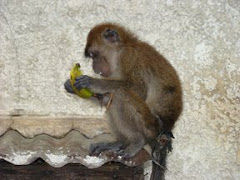19 May 2008
Well, we didn’t quite finish the pharmacy, there were some material issues and we didn’t get the door and windows until almost noon. We just have some cosmetic details to take care of tomorrow and will be out of there by noon one way or the other. I don’t know which job I’ll be off to after that, probably back to the big block job at the main clinic that we are building, it’s probably about time I went back there and see how the electrical is coming. The pharmacy is about 45 minutes away from our compound which gives me a good chance to observe the driving here in this part of the Philippines.
Driving here is more of a contact sport than navigation. I have been to places where lane markings and signs are suggestions, but here they are wishes more than anything. There is a hierarchy on the roads here that must be observed at all costs. Right of way goes first and foremost to the largest vehicle, then the fastest, then the one with the most insistent use of the horn. In the States, the horn is generally used to signal your displeasure to another driver who has done something stupid; here there is an entire vocabulary contained within a few short bursts. I have been able to decode much of what is being said in this morse-like code – one short honk means “I am coming up behind you”, (this is reserved for slow moving pedestrians and human powered tricycles), the longer single honk is meant for engine powered tricycles and is a warning to move to the right. Two honks is the signal for “I’m passing you regardless of safety and road conditions because I’m faster” – this one also doubles to let the oncoming driver know that the vehicle couldn’t care less about you, so you better move to the right or you will be pushed off of the road. Three honks is serious and means “ move you slow moving a** or you’re going to get run over” – again, this one is reserved for pedestrians (even the dogs seem to understand this one) and pedal bikes and this signal is usually given approximately 6-12 inches from the offending party’s rear end resulting in an immediate jerking movement out of the vehicle’s path. Four blasts is so far the most serious that I have seen and is only utilized in the most hazardous of situations and usually only occurs every 100 or so feet of travel, this one means “pardon me driver of a larger vehicle, but I did not see you when I blindly pulled out from behind the vehicle that had the nerve to travel slower than I wished to, I would pull back in, but I have not yet had the chance to push the slower, smaller vehicle (pedestrian, bike, pig, cow, rooster, etc.) from the roadway, and would you please slow down momentarily to allow me to do so.” I know that that seems like a lot to cram into 4 toots, but they do it somehow.
The vast majority of vehicles on the road are not motor powered, they are human powered (I did see a kid with a roto-tiller tied to a wagon, he had leaned it back and had the tines in the air, I still haven’t figured out how he steered, but I digress), there are bikes with a third wheel and a cab everywhere you go. There are also motorcycles with the requisite cab also. You could not believe the amount of stuff that can fit into one of these cabs (I say into, but what I really mean is into, on top, below, off to the side, etc.), I even saw one that had the cab converted into a moving livestock cage and contained two pigs, I have no idea how the pigs paid for the cab but since sausage and bacon are delicious I don’t really care. The do have some busses that look like something that Scooby-Doo and the gang painted (picture the mystery machine with about 50 people in it, and again I use the term in loosely).
I have more to say about the transportation here, but will try to save further posting until I have completed more in-depth analysis. I do have a theory as to why people stare at me everywhere I go, and contrary to popular belief, it is not because I am 6’4”, 220lbs, and have red hair – it’s because I don’t walk around carrying a rooster - but more on that next time.
Subscribe to:
Post Comments (Atom)

No comments:
Post a Comment